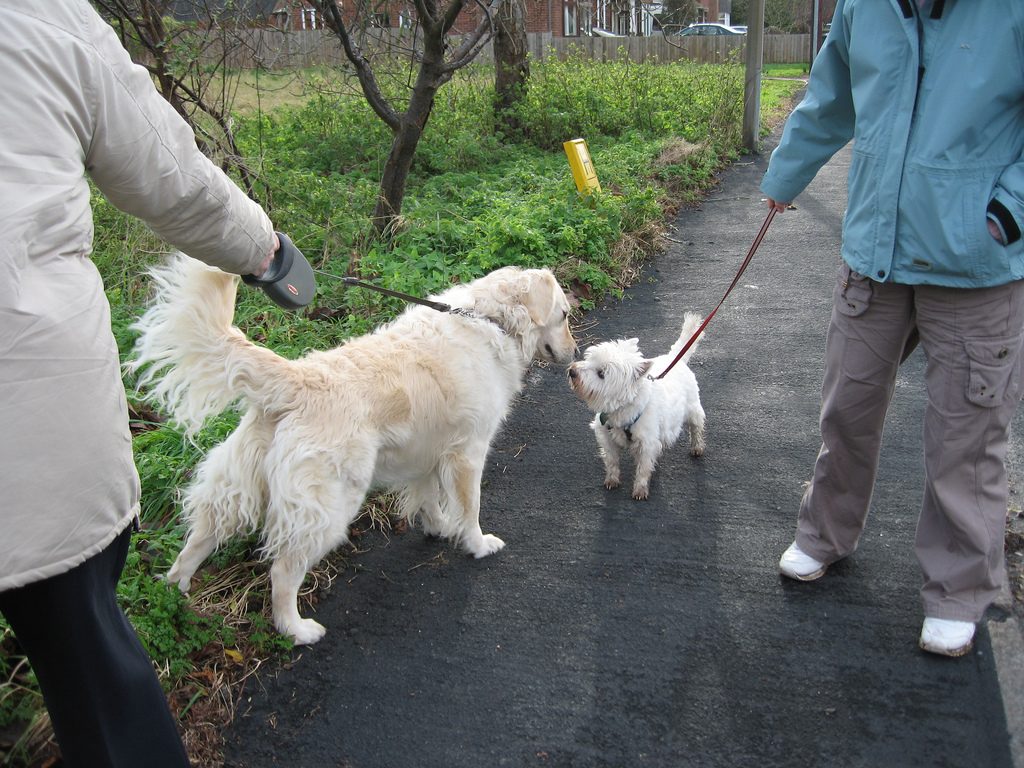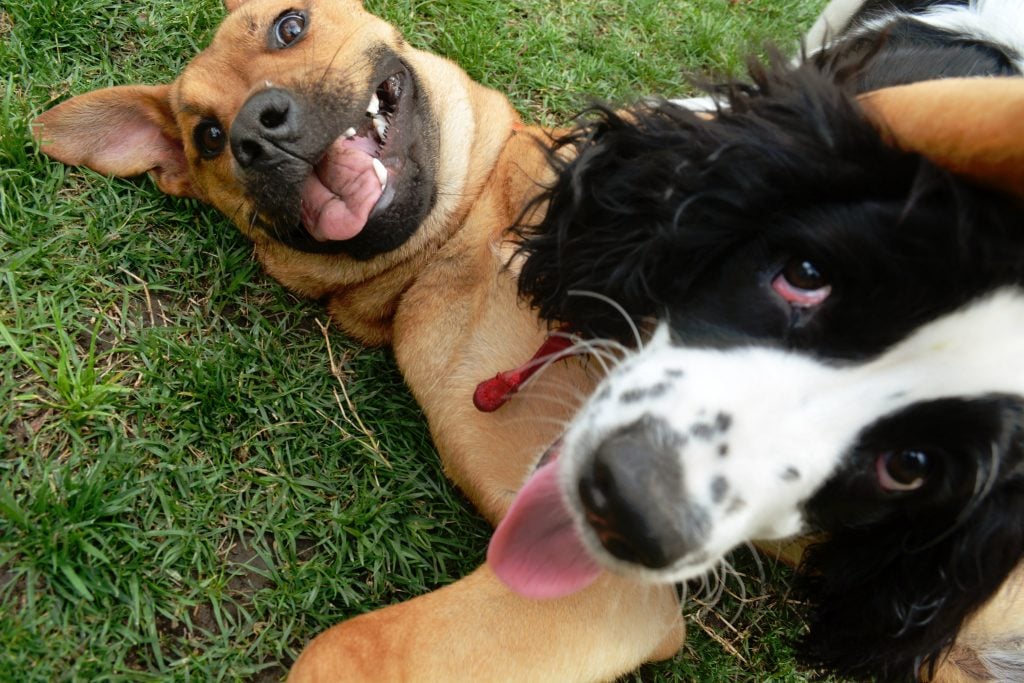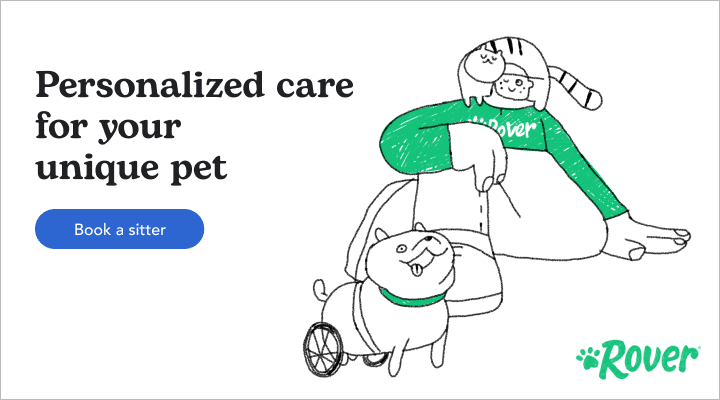- This post contains affiliate links. Read more here.
It’s your golden retriever’s world and we’re just living in it—but that doesn’t mean your buddy gets a free pass on being prim and proper. Make sure your dog is an upstanding canine citizen with the following steps.
How to Socialize Your Dog with Humans
Daily Walks Are Key
Just taking your dog out to a public place and walking around will help him grow more comfortable with the world and people around him. From cars driving down the street to the mailman, the world becomes a little bit less scary once you’ve been around the block a time or two.
Keep your buddy on a short leash and get your exercise on—there’s a lot to see and plenty to smell. Take different routes, allowing your buddy the chance to meet new friends and experience a wide variety of sights.
Mix It Up
Expose your dog to a wide variety of people, from men and women to children, so he can get acclimated to the idea of people (who are much bigger). The idea is that if your dog only ever hangs out with one person, he may grow wary of anyone that isn’t that person, so it’s crucial to diversify your dog’s social calendar and make time for meet-and-greets.
- Stay calm and confident if your dog acts scared. Don’t push, but don’t make a big deal out of skittish behavior, either.
- Ensure that people pet your dog where their hands can be seen, like on your dog’s chest or chin.
- Use treats to give your dog a positive association with new people and experiences.
- Go back to the basics. A dog who is confident with their training and routine makes for a well-rounded pooch.
- Enlist a dog walker or drop-in pet sitter to give your dog exposure to different caregivers during the day.
Be Timely
Between 3 and 12 weeks of age is the sweet spot for socializing a puppy. Check out certified trainer Shoshi Parks’ handy checklist of experiences your pup should be exposed to during this crucial window of time, available here.
Typically, new puppies should be exposed to:
- Unfamiliar people
- Unfamiliar dress (hoods, jackets, sunglasses, hats)
- Body handling (ears, paws, tail, and so on)
- Urban environments
- Parks, bodies of water, woods, and beaches
- Vehicles
- Different types of flooring and ground surfaces
- Common neighborhood objects like street signs, bicycles, strollers, skateboards, benches
- Cats
- Other dogs
Beyond 18 weeks (about four months) it becomes a lot more difficult to socialize a dog—though not impossible! Don’t be dismayed if you have an older dog, because you can teach an old dog new tricks. If you need to socialize an older rescue dog, this article provides plenty of great tips on how to do it.
Dog Classes
A little boot camp action never hurt anyone—or puppy kindergarten, for that matter. Ask your vet about local dog socializing opportunities that might be a good fit for you and your pet.
Dog training classes are also a great place to meet other dogs and people in a safe and controlled environment.
How to Socialize Your Dog with Other Dogs
Stock up on Treats
Most dogs will do anything for a treat, so it’s handy to have a stash of these to keep your dog on his best behavior. Anytime your dog has a successful interaction with another dog, what do you do? You guessed it—give ’em a treat! This encourages positive social behavior.
Tasty, high-value treats will get more mileage—my dog is crazy for freeze-dried raw treats, but you’ll know your dog’s preferences best. String cheese, bits of cooked chicken, or small pieces of a hardboiled egg are typically very popular with dogs. Just adjust your dog’s calorie intake at mealtime to compensate for the extra calories at snack time.
Hit The Dog Park—or Pet Shop
Let your bright-eyed and bushy-tailed buddy have a lap around the park and make the rounds. If you’re confident about recall, try an off-leash park, or set up a playdate at a friend’s place with their dog.
If you’re short on compostable poop bags or that doggy shampoo that smells so good, hit the store with your dog in tow to check out the goings-on. He might just make a new friend! You’re also likely to meet other dog people in your neighborhood, which can set the stage for puppy playdates later on.
Follow Your Dog’s Cues
Make sure interactions are long enough to get acquainted, but not so long as to wear your buddy out.
It’s just like you and your BFF: spend too much time together and you might start to notice things you never noticed before…for better or for worse.
Exercise Caution
Introducing a three pound Chihuahua to a Great Dane might sound adorable, but remember to exercise caution when introducing dogs.
Always make sure the other party is friendly before facilitating a meet and sniff. Know the signs of discomfort in your dog (excessive panting, yawning, tail between the legs) and act accordingly.
Remember: practice makes perfect and the more successful interactions your dog has with his brethren, the easier it will get.
Further Reading
- What Puppy Socialization Really Means
- Pet Socialization and Wellness During and After a Pandemic: What the Experts Say
- The Truth About Socializing a Puppy and How to Do It Well
Top image via Flickr CC




